|
Exploring Nature's spending habits...
On the What is life page I suggested a number of possibilities for how life may have begun on earth. One of them was: "Perhaps the universe is arranged in a way, not obvious to us now, that favors the rise of lifeforms from inanimate matter - in spite of the evident tendency of things to proceed naturally from order to disorder." Now I am faced with trying to explain what I had in mind with that statement. On previous pages I have suggested that the development of life with all its complexity required something other than pure chance. I am aware of other instances of complexity arising from very simple rules. Simple mechanical systems can be made to exhibit such bizarre behavior that until the last third of the 20th century whenever that behavior was observed, the assumption was made that the data must be contaminated with some sort of random noise. I wonder if there might be hidden order underlying the development of life as there turns out to be underlying this bizarre mechanical behavior. I can not prove this but I can on a single (rather long) page try to make the mechanical case understandable to folks not previously familiar with it.
This page is going to lead you into some places where you may have not gone before. It involves the somewhat abstract idea of an
attractor. The simplest example of an attractor involves a pendulum consisting of a rigid rod with a weight on one end and the other end suspended from a pivot. There will always be some friction at the pivot for any real pendulum as well as friction of the moving parts passing through the air. After an initial displacement the pendulum will ultimately come to rest hanging strait down. The point directly under the pivot is an attractor for the pendulum system. Whatever sort of start you give the pendulum it will always end up on its attractor, hanging motionless and vertical.

|
The upper, real space, image at the left is a snapshot of the pendulum described above as it seeks its attractor. Below the line, the plot space view of the pendulum, shows the position in red and velocity in green, of the pendulum weight versus time. I have chosen to show the time axis vertical to emphasize the connection between the amplitude of the graphs with the physical motion of the pendulum weight. Although only the first few swings is shown, clearly in time the pendulum would reach its attractor hanging motionless directly under the pivot.
|
|
Let's turn the graph around to the more customary orientation and drop the picture of the physical pendulum for a more conventional view of the pendulum's behavior. Also I have introduced a more general notation for the position and velocity, that we will see in more complex examples. The p symbol for pendulum position has been replace with the general variable x. The v for velocity symbol has been replaced by x', where the ' superscript denotes the rate of change so we are plotting position, x, and velocity, the rate of change of position, x'. These two numbers x and x' at any instance in time make up the state of the pendulum at that instant.
|
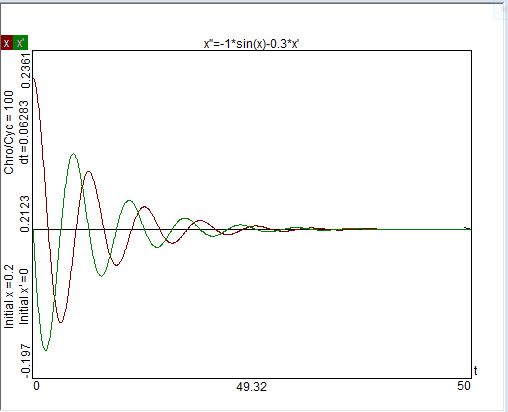
|
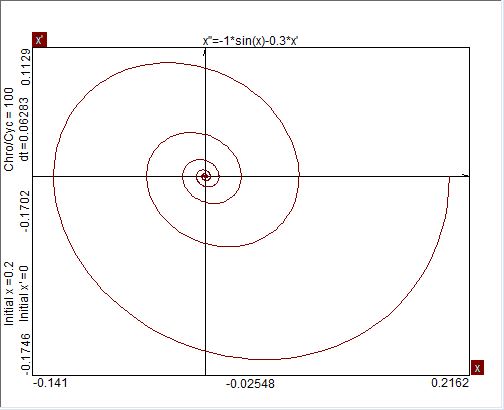
|
There is a more instructive way to display the state of a system as it approaches its attractor. We can create a plot with each of the state variables along its own axis and let time be implicit instead of being explicit with its own axis. The image at the left is an example specific to the pendulum we have been studying. The plot of system states spirals through this state space to come to its attractor which is a single point at the origin, point (0,0). This space with state variables is known in the literature as phase space. The path the system takes through phase space is called its phase space orbit. No matter how bizarre the initial conditions of position and velocity are, the pendulum spinning around its pivot point a hundred times a minute for example, the attractor ultimately collects the pendulum. That is the power of the attractor idea. The universe allows for all sorts of outrageous behavior but in the end the attractor brings systems to some sort of order. By identifying the attractor for even very complicated systems we can know something about their long term behavior, even if we do not understand all the details of the system.
|
|
Now I want to introduce a different mechanical system known as the Duffing mechanical oscillator (DMO) in honor of Georg Duffing who studied this machine in the early years of the twentieth century. It has some things in common with the pendulum. There is a moving part that moves back and forth under the influence of an electro-magnet instead of under the influence of gravity as was the case with the pendulum. The DMO is represented schematically a the right.
it consists of two rigid supports with a metal strip stretched between them. A solidly mounted elecgtro-magnet with alternating current flowing through it causes the metal strip to vibrate, analogous to the swinging of the pendulum. The symbols x and x' may be taken to represent the position and velocity of the center of the strip as it is alternately pulled and released by the magnet. The diagram grossly exaggerates the amount of displacement of the strip.
|
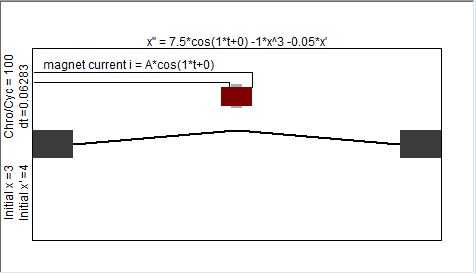
|
Now if we plot x and x' for the DMO as a function of time we get the mess shown below. In about the first quarter of this graph the gyrations settle down a bit. That represents the system finding its attractor. The remainder of the graph shows no sign of settling out on the time axis. In fact it is found that however long the system runs, the state of the system never repeats. Wherever we look along the time axis the combination of position and velocity at that time is unique even though the driving force from the magnet is perfectly regular, repeating every 6.28 time units. This completely irregular, persistent behavior is a challenge to our notion of an attractor eventually drawing in the behavior of the system.

|
Perhaps we can see more order in this chaos if we change our point of view to look at the phase space (x,x') orbit for this system. Remember that the pendulum orbit was a spiral that quickly closed on the single point attractor. The image at the right shows the phase space orbit after a run of 250 time units, plenty of time for the system to find its attractor. We can see that the orbit is a jumble of strands that lie in small and large loops. If we ran this model even longer we would see that the strands would essentially fill in the entire figure. Notice that the sort of two lobed tangle of strands lies in a well defined region of the total phase space. Most of that space is never visited by the system. The few outlying strands are the path the system took to arrive at this complicated attractor. I made the point previously that while on this attractor, the system never revisits a state no matter how long it is observed. This appears to be contradicted by the frequent crossing and overlaying of the strands. It appears that in throwing out the time axis we have lost some information about the nature of this attractor. We got away with it in the pendulum case because of the simple approach to the point attractor. A spiral remains a spiral whether stretched out or squashed flat onto the (x,x') plane.
|
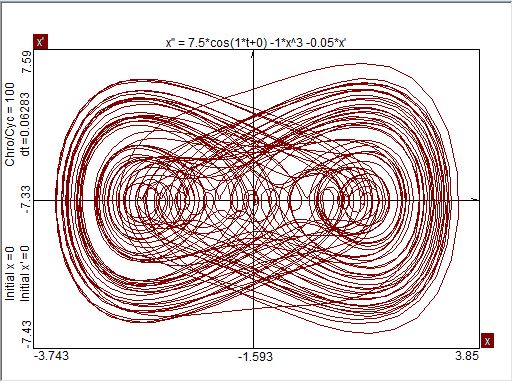
|
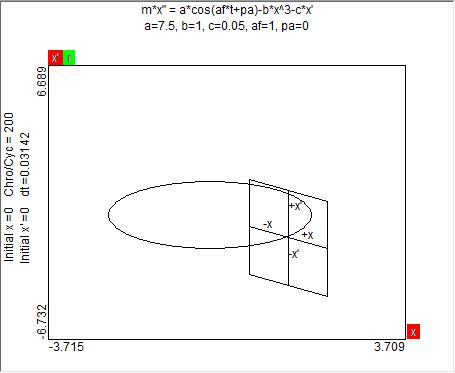
|
Adding the time axis back in to the phase space picture complicates the presentation. Fortunately there is a trick we can use to keep the end of the time axis from disappearing over the horizon. As far as the DMO system in concerned the time dependence is driven by the current through the electro-magnet which repeats the same cycle over and over again. This allows us to represent the time axis as a circle as shown on the three-dimensional diagram at the left. The circular time axis passes perpendicularly through the the (x,x') plane at the origin (0,0).
|
|
The image at the right shows the DMO phase space orbit limited to four circuits around the circular time axis. While still highly irregular, when compared to the two-dimensional view, the four strands have been disentangled by the addition of the time axis. If I interfere with the vibrating strip by poking it so that its state moves off its attractor, in a strand or so the motion returns to the attractor, but from the then on the track, on the attractor, has no necessary relationship to what it would have been in the absence of the poke that I gave it. Notice that strands in this bundle are also marked by a contrasting color where they pierce the (x, x') plane.
|
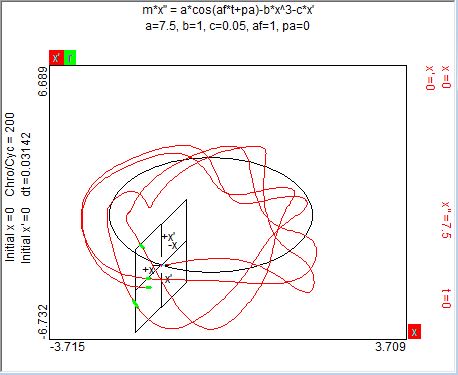
|
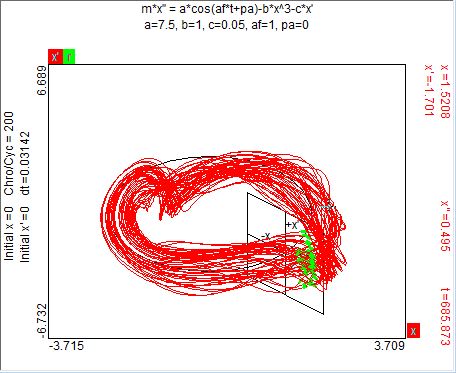
|
At the left we have let the model run a bit longer to illustrate by means of the green marks where the strands are cut by the (x,x') plane. It is difficult to appreciate the intricate structure of the attractor on which these strands lie from looking at the bundle of strands itself. If we let the model run for a long time, the bundle of orbit strands look like a solid mass. This is just an artifact of the computer display. In fact the strands are infinitely fine and never intersect. If we slice the orbit perpendicular to the time axis, the cross section reveals the intricate structure of the phase space orbit. We will look at that next.
|
|
To hide some of the obscuring detail in the strands themselves, we can just look at that region of the (x, x') plane where the green spots mark the intersection of the strands with that plane, as shown at the right. This effectively shows the cross section of the attractor as cut by the (x, x') plane. If we cut the attractor at different locations on the circular time-axis we would find that the attractor cross section changes, stretching and twisting in such a way that when we get back to the (x, x') plane the structure shown at the right is restored. Of course the structure shown at right is an incomplete cross section. It is made up of dots where a finite number of strands intersect the (x, x') plane. We would have to run the model forever to get the complete picture. I have not run the model that long, but even in the fairly brief run shown here where a few thousand pixels are illuminated, it is clear that the attractor is a complicated and intricate structure. It is an infinitely folded and twisted two-dimensional object occupying no volume because the object has no thickness, yet taking up space with an efficiency somewhere between two and three dimensions, maybe about 2.2 or so. Being of fractional dimension an object of this sort is called a fractal.
|
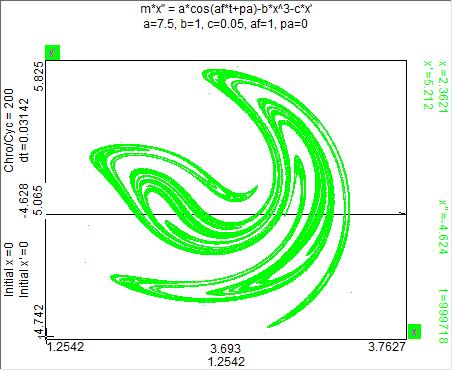
|
One important aspect of attractors is that they exist for many sorts of dynamical systems, not just simple mechanical systems. Dynamical systems analysis is now applied in the fields of aerodynamics, biology, chemistry, ecology, engineering, medicine, process controls and sociology; and probably many others that have escape my my notice, or my recall at the moment. It seems that in spite of Nature's preference for simple rules and minimum action she is a secret lover of complexity. Who would have guessed that from Newton's laws of motion, familiar to every high school physics student, would arise an "object" as complex as the attractor we have seen here. It is true that this object resides in a space one level of abstraction below the ordinary space of length, width and height that we live in but its influence is clearly demonstrated in the motion of the metal strip in our "real" space. Wouldn't it be interesting if Nature's laws of chemistry, more complicated and less well understood than Nature's laws of motion as written down by Newton over three centuries ago, gave rise to an attractor whose influence was demonstrated in the existence of life on Earth.
On this page I suggested that perhaps the universe is arranged in a way, not obvious to us now, that favors the rise of lifeforms from inanimate matter. Clearly I have not proved that this is so but I have suggested a possible mechanism, the attractor, to improve on raw chance in bringing forth life. That leaves the last perhaps in my list. Maybe as was the case in assembling the jigsaw puzzle, the application of intelligence accomplishes what chance alone could not do in thousands of our universe's lifetimes. I will pursue this notion in the next page.
|




